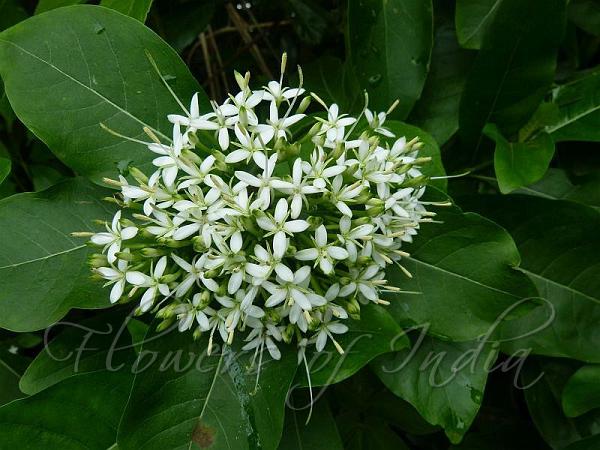|
| Indian Pavetta |
|

|

|
|
|
Photo: |
Botanical name: Pavetta indica Family: Rubiaceae (Coffee family)
Synonyms: Pavetta alba, Pavetta obtusa, Ixora indica
Synonyms: Pavetta alba, Pavetta obtusa, Ixora indica
Indian Pavetta is an erect, nearly smooth or somewhat hairy shrub 2 to 4
meters or more in height. The leaves are elliptic-oblong to elliptic-lanceolate,
6-15 cm long, and pointed at both ends. The flowers are white, rather
fragrant, and borne in considerable numbers in hairy terminal panicles which
are 6-10 cm long. The sepals are very small, and toothed. The flower-tube
is slender and about 1.5 cm long, with obtuse petals about half the length of
the tube. The flowers attract butterflies and insects. The fruit is black when
dry, somewhat rounded, and about 6 mm in diameter.
Medicinal uses: The bark, in decoction, or pulverized, is
administered, especially to children, to correct visceral obstructions. The
decocted leaves are used externally to alleviate the pains caused by
haemorrhoids. The root, pulverized and mixed with the ginger and rice-water,
is given in dropsy. A local fomentation with the leaves is useful in relieving
the pain of piles.
The bark, in decoction, or pulverized, is
administered, especially to children, to correct visceral obstructions. The
decocted leaves are used externally to alleviate the pains caused by
haemorrhoids. The root, pulverized and mixed with the ginger and rice-water,
is given in dropsy. A local fomentation with the leaves is useful in relieving
the pain of piles.
Medicinal uses:
 The bark, in decoction, or pulverized, is
administered, especially to children, to correct visceral obstructions. The
decocted leaves are used externally to alleviate the pains caused by
haemorrhoids. The root, pulverized and mixed with the ginger and rice-water,
is given in dropsy. A local fomentation with the leaves is useful in relieving
the pain of piles.
The bark, in decoction, or pulverized, is
administered, especially to children, to correct visceral obstructions. The
decocted leaves are used externally to alleviate the pains caused by
haemorrhoids. The root, pulverized and mixed with the ginger and rice-water,
is given in dropsy. A local fomentation with the leaves is useful in relieving
the pain of piles. | Identification credit: Surajit Koley | Photographed in Hoogly, West Bengal. |
• Is this flower misidentified? If yes,